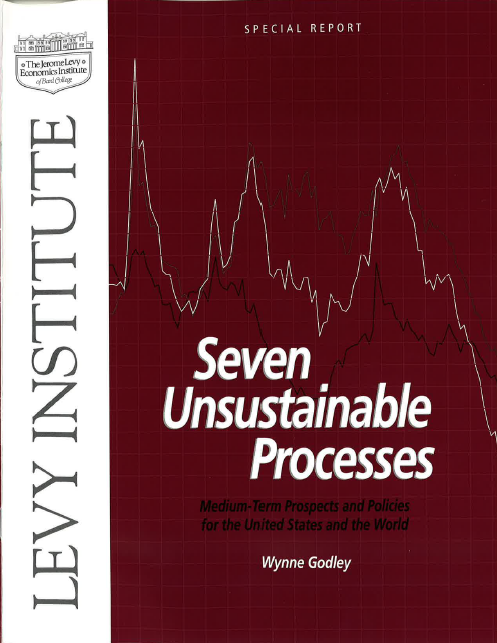Of all the economists, Wynne Godley had the rarest of rare ability to model and imagine the economic dynamics of the whole world. “… a full macroeconomic model in his head, which, by some sort of subconscious process, he computed.” as his obituary from FT said.
In the recent INET conference paper, Dirk Bezemer discusses Wynne Godley’s approach (among others’) and also refers to his paper Seven Unsustainable Processes from 1999.
I obtained this original scanned copy of the paper Seven Unsustainable Processes – Medium Term Policies For The United States And The World by Wynne Godley from 1999 from the Levy Economics Institute and thought that since this version is missing for some reason from the levyinstitute.org website, I’ll post it here (after asking them if I may post).
Click to see the pdf.

Here’s the link to the updated version of the paper from the year 2000. The original had a typo. Two columns in Table 1 appeared with incorrect headings (should have been the reverse).
 Wynne Godley at the Levy Institute
Wynne Godley at the Levy Institute
Godley warns of the private sector indebtedness:
… Moreover, if, per impossibile, the growth in net lending and the growth in money supply growth were to continue for another eight years, the implied indebtedness of the private sector would then be so extremely large that a sensational day of reckoning could then be at hand.
Wynne Godley never liked the chimerical and primitive view of economists where anything and everything is traded in the markets via supply and demand. So,
The difference between the consensus view and that put forward here could not exist without a profound difference in the view of how the economy works. So far as the author can observe, the underlying theoretical perspective of the optimists, whether they realize it or not, sees all agents, including the government, as participants in a gigantic market process in which commodities, labor, and financial assets are supplied and demanded. If this market works properly, prices (e.g., for labor and commodities) get established that clear all markets, including the labor market, so that there can be no long-term unemployment and no depression. The only way in which unemployment can be reduced permanently, according to this view, is by making markets work better, say, by removing “rigidities” or improving flows of information. The government is a market participant like any other, its main distinguishing feature being that it can print money. Because the government cannot alter the market-clearing price of labor, there is no way in which fiscal or monetary policy can change aggregate employment and output, except temporarily (by creating false expectations) and perversely (because any interference will cause inflation).
No parody is intended. No other story would make sense of the assumption now commonly made that the balance between tax receipts and public spending has no permanent effect on the evolution of the aggregate demand. And nothing else would make sense of the debate now in full swing about how to “spend” the federal surplus as though this were a nest egg that can be preserved, spent, or squandered without any need to consider the macroeconomic consequences.
The seven unsustainable processes were:
(1) the fall in private saving into ever deeper negative territory, (2) the rise in the flow of net lending to the private sector, (3) the rise in the growth rate of the real money stock, (4) the rise in asset prices at a rate that far exceeds the growth of profits (or of GDP), (5) the rise in the budget surplus, (6) the rise in the current account deficit, (7) the increase in the United States’s net foreign indebtedness relative to GDP.
As it happened, the United States went into a recession but recovered quickly because of further deregulations and low interest rates which led to more borrowing, and a fiscal stimulus which put a floor on the downfall. However, the private sector went back into deficits and its indebtedness kept rising relative to income. The current balance of payments also went deeply in deficit rising to about 6.43% at the end of 2005 – hemorrhaging the circular flow of national income at a massive scale. See the related post here: The Un-Godley Private Sector Deficit.
Not only did Godley see the crisis coming, he also figured out that the United States will soon run into policy issues and will have less room to come out of a crisis. In this 2005 strategic analysis paper The United States And Her Creditors – Can The Symbiosis Last? he and his collaborators (Dimitri Papadimitriou, Claudio Dos Santos and Gennaro Zezza) pointed out that:
The range of strategic policy options for the United States is beginning to narrow … As the normal equilibrating forces (changes in exchange rates) are being subverted, it is very far from obvious what the United States can do on her own …
In his last ever article, Prospects For The United States And The World – A Crisis That Conventional Remedies Cannot Resolve (from which I got the subtitle of my blog!), Godley and collaborators (Dimitri Papadimitriou and Gennaro Zezza) said:
The prospects for the U.S. economy have become uniquely dreadful, if not frightening. In this paper we argue, as starkly as we can, that the United States and the rest of the world’s economies will not be able to achieve balanced growth and full employment unless they are able to agree upon and implement an entirely new way of running the global economy.
Stressing the need for concerted action (from which I got the title of my blog!), the authors said:
… Fiscal policy alone cannot, therefore, resolve the current crisis. A large enough stimulus will help counter the drop in private expenditure, reducing unemployment, but it will bring back a large and growing external imbalance, which will keep world growth on an unsustainable path …
… What must come to pass, perhaps obviously, is a worldwide recovery of output, combined with sustainable balances in international trade. Since this series of reports began in 1999, we have emphasized that, in the United States, sustained growth with full employment would eventually require both fiscal expansion and a rapid acceleration in net export demand. Part of the needed fiscal stimulus has already occurred, and much more (it seems) is immediately in prospect. But the U.S. balance of payments languishes, and a substantial and spontaneous recovery is now highly unlikely in view of the developing severe downturn in world trade and output … By our reckoning (which is put forward with great diffidence), if the United States were to attempt to restore full employment by fiscal and monetary means alone, the balance of payments deficit would rise over the next, say, three to four years, to 6 percent of GDP or more—that is, to a level that could not possibly be sustained for a long period, let alone indefinitely …
… It is inconceivable that such a large rebalancing could occur without a drastic change in the institutions responsible for running the world economy—a change that would involve placing far less than total reliance on market forces.